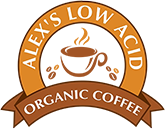Take a sip of Alex’s Low-Acid Organic Coffee. Savor the balance of flavors and appreciate how smooth it is. Enjoy the mellowness. And wonder…where did these coffee beans come from?
Alex’s Low-Acid Organic Coffee is a blend of the finest quality Arabica beans from some of the major coffee growing regions in the world. Each of our coffees, whether Whole Bean or Ground, and whether Regular, Decaffeinated, or Half Caff, includes a blend of coffee beans from the Chiapas region of Mexico, from Nicaragua, and from Honduras. They’re 100% USDA certified organic, and they’re guaranteed perfectly fresh and low in acid. Here’s where Alex’s Low-Acid Organic Coffee comes from!
Chiapas Region: Leading the Charge from Mexico
Mexico’s coffee industry encountered a roadblock when coffee leaf rust hit about 10 years ago. After some challenging years of decreased production, coffee is experiencing a comeback in Mexico. The state with the greatest production in Mexico is Chiapas. It was first to get hit by coffee leaf rust, and has been first to recover. Nearly half of Mexican coffee bean exports are from Chiapas, and they make up 50% of Alex’s Low-Acid Organic Coffee.
Chiapas is in southern Mexico, between Oaxaca and the border of Guatemala. It is at high altitude and has nutrient-rich soil, just like that of Guatemala. Coffee beans from this region are mild and delicate. They have sweet hints of brown sugar and ripe pears, along with nutty overtones.
Nicaragua: Traditional Coffee Powerhouse
Coffee beans have been among Nicaragua’s major exports for years. It makes sense, since Nicaragua has many characteristics that make it ideal for coffee production. It’s at a middle altitude and has volcanic, nutrient-rich soil.
Plus, coffee-growing regions of Nicaragua lend themselves to organic production. First, there is a natural canopy, allowing for natural shade growth to protect young coffee shoots from the sun. And, there are natural predators that help control pests without the need for toxic chemicals that could harm people or the environment.
Alex’s Low-Acid Organic Coffee gets 25% of its beans from Nicaragua. Coffee from these beans is balanced and subtle. You might detect hazelnut, vanilla, and citrus notes when you sip Alex’s Low-Acid Organic Coffee.
Honduras: Coffee Industry of Growing Importance
Honduras is responsible for 5% of the world’s coffee production, and it has the highest per capita coffee production in the world. Located in Central America and bordering Guatemala, El Salvador, and Nicaragua, this country was also hit hard by the coffee leaf rust crisis about a decade ago, but it is recovering.
Honduras has mid-level elevation and produces the main varieties of Arabica beans. The flavors are mild and appealing to a wide range of consumers. They include fruity hints of tropical fruits and berries, as well as chocolate and vanilla notes. Coffee beans from Honduras account for 25% of the coffee in Alex’s Low-Acid Organic Coffee blends.
Basics of Coffee Production: How It Works
Now that you know where our coffee beans come from, here’s an overview of how coffee beans are produced and get to you. It’s a long labor of love, and a pretty neat process!
Alex’s Low-Acid Organic Coffee starts its life when coffee seeds are planted. They need to be protected from the sun, so they may be in nurseries or in shady areas to start. Then comes a long growth period. It can take about 5 years from planting to harvest, which takes place during the dry season. Only the best coffee fruits, or coffee cherries, are kept.
Then there is a process to remove the coffee beans from their pods in the cherry. Once the best beans are separated out, they’re allowed to ferment and then dry. The beans are sorted and the hulls are removed. Then they get exported and tested for quality.
Next comes the roasting process, which is where Alex’s Low-Acid Organic Coffee really separates itself. The beans are perfectly roasted to a medium dark French Roast. That’s enough to bring out a chocolatey flavor to perfectly complement the other flavors in this blend of coffee beans.
Another key to the roasting process is how it’s done. This is the step that turns Alex’s Low-Acid Organic Coffee into a lower acid coffee compared to other brands. The coffee beans are processed using convection heat. They never come into contact with hot metal, and this keeps them lower in acid.
Finally, the beans are uniquely packaged to stay fresh until they get to you.
All of Our Beans Are Organic
Though we get our beans from three different countries, they’re all certified organic. That’s because we respect the land that our coffee beans are grown on, the farmers who grow them, and you, our customers. Our coffee beans go through the National Organic Program, which is sponsored and regulated by the Department of Agriculture (USDA).
To be organic, there are standards and quality control guidelines from production through processing and packaging. The soil needs to be free from a long list of potentially harmful substances for years before planting, and coffee cannot come into contact with any of these pesticides, herbicides, or fungicides either. The USDA’s NOP considers human health as well as environmental impacts relating to carbon footprints and ecosystems.
Organic decaffeinated coffee, such as Alex’s Low-Acid Organic Decaf Coffee, uses a special process without chemical solvents. The Swiss Water Process uses hot water and filters to remove the caffeine from the beans. No toxic chemicals are involved.
If you want the best coffee experience, you have to have the best-tasting beans with a level of acidity that you can handle. Alex’s Low-Acid Organic Coffee contains Arabica beans from Chiapas in Mexico, Nicaragua, and Honduras, and they’re completely organic. When you receive your coffee beans, you can be sure you’ll have the freshest beans and an experience that is top-notch.

